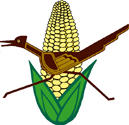
The Santa Fe-based organization Farm to Table, with the help of a coalition of state agencies and non-governmental organizations (Project Advisory Team, PAT), has initiated a very interesting study to determine the extent by which rural communities in New Mexico have difficulties securing a healthy and affordable diet.
New Mexico already ranks high in several categories, such as food insecurity and childhood poverty. It would be interesting to see how much rural poverty contributes to the overall trends for the state. See Roadrunner Food Bank's Fact Sheet. Roadrunner Food Bank is attempting to address the problem of childhood poverty through its Food for Kids Program. (The above logo is borrowed from the Roadrunner Food Bank website).
A report from America's Second Harvest points to several factors that promote hunger in rural communities: Fewer jobs are available in rural areas than in urban areas. Rural residents face long commutes to get to jobs and childcare providers. Housing costs and unemployment rates are high. The need for cars is often greater in rural areas than cities due to longer distances to products and services and the pervasive lack of public transportation. Access to social service programs for the rural elderly poor is more limited than in urban and suburban communities. Read Report on Rural Hunger from America's Second Harvest
The coordinators of the Farm to Table/PAT study--Pam Roy, Miles Patrie and Joseph Lee--are starting in northwest, north-central and central New Mexico, but are hoping to extend the study to other parts of the state as additional funding becomes available. Interviews will be conducted in three areas selected from Cibola, McKinley, Rio Arriba, Socorro, San Juan and Mora Counties and the Zuni, Navajo, and Acoma Nations. These areas were selected because of their high and persistent poverty rates, long travel distance to food sources, and geographical isolation.
"Initially we will engage local leaders, stakeholders, and interested community organizations about the rural food gap," said a study proposal. "These community contacts will help provide background about the area, thoughts on the size and effects of the rural food gap, and aid in bringing together focus groups."
The findings and resources created by this project will be shared with communities, organizations and interested parties throughout New Mexico, including public officials. We will try to publish a summary of the study results when they are available. In the meantime, please contact Pam Roy (pamelaroy@aol.com), Miles Patrie (mpatrie@hungercenter.org), or Joseph Lee (jlee@hungercenter.org) if you have any questions or want more information.
The Project Advisory Team includes: The New Mexico Food and Agriculture Policy Council; The New Mexico Task Force to End Hunger; New Mexico Legal Aid; the New Mexico Association of Food Banks; the New Mexico Tribal Extension Task Force; the Congressional Hunger Center; The Navajo Nation Department of Agriculture; New Mexico State University Cooperative Extension Service; Obesity Prevention; The Physical Activity and Nutrition Program of the New Mexico Department of Health; the New Mexico Rural Development Response Council; and the New Mexico Farmers Marketing Association.
No comments:
Post a Comment